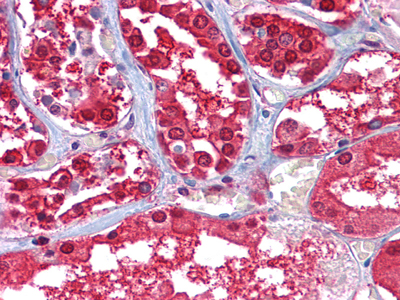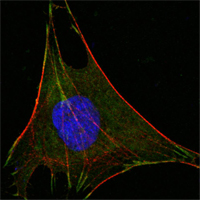GPI Monoclonal Antibody
- Catalog No.:YM0312
- Applications:WB;IHC;IF;ELISA
- Reactivity:Human
- Target:
- GPI
- Fields:
- >>Glycolysis / Gluconeogenesis;>>Pentose phosphate pathway;>>Starch and sucrose metabolism;>>Amino sugar and nucleotide sugar metabolism;>>Metabolic pathways;>>Carbon metabolism;>>Biosynthesis of nucleotide sugars
- Gene Name:
- GPI
- Protein Name:
- Glucose-6-phosphate isomerase
- Human Gene Id:
- 2821
- Human Swiss Prot No:
- P06744
- Mouse Swiss Prot No:
- P06745
- Immunogen:
- Purified recombinant fragment of human GPI expressed in E. Coli.
- Specificity:
- GPI Monoclonal Antibody detects endogenous levels of GPI protein.
- Formulation:
- Liquid in PBS containing 50% glycerol, 0.5% BSA and 0.02% sodium azide.
- Source:
- Monoclonal, Mouse
- Dilution:
- WB 1:500 - 1:2000. IHC 1:200 - 1:1000. IF 1:200 - 1:1000. ELISA: 1:10000. Not yet tested in other applications.
- Purification:
- Affinity purification
- Storage Stability:
- -15°C to -25°C/1 year(Do not lower than -25°C)
- Other Name:
- GPI;Glucose-6-phosphate isomerase;GPI;Autocrine motility factor;AMF;Neuroleukin;NLK;Phosphoglucose isomerase;PGI;Phosphohexose isomerase;PHI;Sperm antigen 36;SA-36
- Molecular Weight(Da):
- 63kD
- References:
- 1. Biochem Biophys Res Commun. 2004 Oct 15;323(2):518-22.
2. Biochem Biophys Res Commun. 2006 Oct 20;349(2):838-45.
3. Hum Mutat. 2006 Nov;27(11):1159.
4. Leuk Lymphoma. 2006 Oct;47(10):22
- Background:
- This gene encodes a member of the glucose phosphate isomerase protein family. The encoded protein has been identified as a moonlighting protein based on its ability to perform mechanistically distinct functions. In the cytoplasm, the gene product functions as a glycolytic enzyme (glucose-6-phosphate isomerase) that interconverts glucose-6-phosphate and fructose-6-phosphate. Extracellularly, the encoded protein (also referred to as neuroleukin) functions as a neurotrophic factor that promotes survival of skeletal motor neurons and sensory neurons, and as a lymphokine that induces immunoglobulin secretion. The encoded protein is also referred to as autocrine motility factor based on an additional function as a tumor-secreted cytokine and angiogenic factor. Defects in this gene are the cause of nonspherocytic hemolytic anemia and a severe enzyme deficiency can be associated with hydrops fetalis
- Function:
- catalytic activity:D-glucose 6-phosphate = D-fructose 6-phosphate.,disease:Defects in GPI are a cause of hereditary nonspherocytic hemolytic anemia (HA) [MIM:172400]. Severe GPI deficiency can be associated with hydrops fetalis, immediate neonatal death and neurological impairment.,function:Besides it's role as a glycolytic enzyme, mammalian GPI can function as a tumor-secreted cytokine and an angiogenic factor (AMF) that stimulates endothelial cell motility. GPI is also a neurotrophic factor (Neuroleukin) for spinal and sensory neurons.,online information:Phosphoglucose isomerase entry,online information:The Singapore human mutation and polymorphism database,pathway:Carbohydrate degradation; glycolysis; D-glyceraldehyde 3-phosphate and glycerone phosphate from D-glucose: step 2/4.,PTM:Phosphorylation at Ser-185 by CK2 has been shown to decrease enzymatic activity and may contribute to s
- Subcellular Location:
- Cytoplasm . Secreted .
- Expression:
- B-cell lymphoma,Brain,Skin,Spleen,Testis,
- June 19-2018
- WESTERN IMMUNOBLOTTING PROTOCOL
- June 19-2018
- IMMUNOHISTOCHEMISTRY-PARAFFIN PROTOCOL
- June 19-2018
- IMMUNOFLUORESCENCE PROTOCOL
- September 08-2020
- FLOW-CYTOMEYRT-PROTOCOL
- May 20-2022
- Cell-Based ELISA│解您多样本WB检测之困扰
- July 13-2018
- CELL-BASED-ELISA-PROTOCOL-FOR-ACETYL-PROTEIN
- July 13-2018
- CELL-BASED-ELISA-PROTOCOL-FOR-PHOSPHO-PROTEIN
- July 13-2018
- Antibody-FAQs
- Products Images

- Western Blot analysis using GPI Monoclonal Antibody against HepG2 (1), SMMC-7721 (2) cell lysate and rat liver tissues lysate (3).

- Immunohistochemistry analysis of paraffin-embedded human Kidney tissues with AEC staining using GPI Monoclonal Antibody.

- Confocal immunofluorescence analysis of L-02 cells using GPI Monoclonal Antibody (green). Red: Actin filaments have been labeled with DY-554 phalloidin. Blue: DRAQ5 fluorescent DNA dye.



